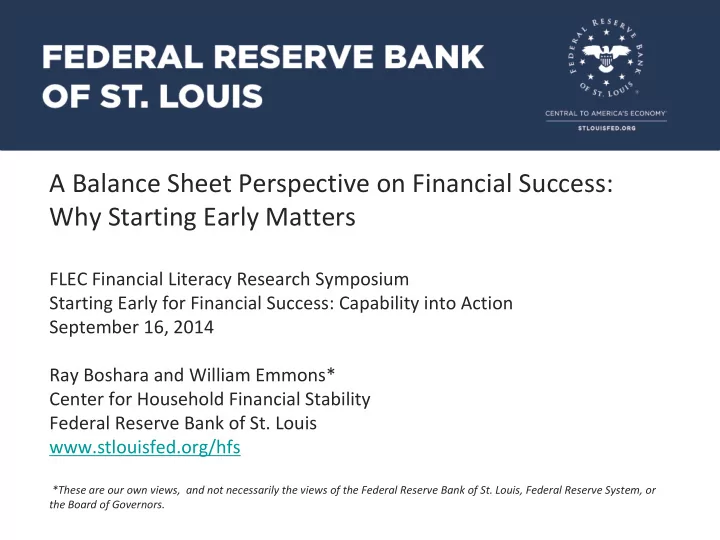

A Balance Sheet Perspective on Financial Success: Why Starting Early Matters FLEC Financial Literacy Research Symposium Starting Early for Financial Success: Capability into Action September 16, 2014 Ray Boshara and William Emmons* Center for Household Financial Stability Federal Reserve Bank of St. Louis www.stlouisfed.org/hfs *These are our own views, and not necessarily the views of the Federal Reserve Bank of St. Louis, Federal Reserve System, or the Board of Governors.
Why a Balance Sheet Perspective on Financial Capability? The balance sheet unites, and offers a common framework for, a wide array of usually siloed efforts to build financial capability. Strategies to build healthy balance sheets reinforce positive financial capability behaviors and, in fact, serve as a useful measure of the success of financial capability efforts. When we were too focused on building assets at the expense of the health of the broader balance sheet, both families and the economy were harmed. The housing boom and bust illustrates the need for a balance- sheet perspective.
Who Lost Wealth in the Great Recession? The Role of Age, Education and Race/Ethnicity % change, 2007 to 2013 Percent Younger families • Under 40: -35.5% • Age 40-61: -47.6% Less-educated families • Less than HS: - 53.6% • High school grads: -45.3% Historically disadvantaged families • African-Americans: -42.6% • Hispanics: -41.8% Source: Federal Reserve Board, Survey of Consumer Finances 3
Young Families Have Very Little Wealth 2013 dollars Source: Federal Reserve Board, Survey of Consumer Finances
Non-Elderly Families Suffered Largest Wealth Losses Index values equal 100 in 1989 Source: Federal Reserve Board, Survey of Consumer Finances
Why Do Younger Families Have Relatively Weak Balance Sheets? Economically vulnerable families assumed greater balance sheet risk — especially over investment in homeownership financed with too much debt while having inadequate liquid savings and other buffers Greater reliance on student loans Happen to follow the “luckiest” generations Relatively lower levels of wealth among younger Americans means less available resources for them to invest in their children.
Consequences of Low Financial Capability When Young: A Rush into Homeownership by Gen X/Gen Y Hurt Them and the Economy Percentage points Baby Boomers Generation X Gen Y Source: Census Bureau
Potential Impacts of Early Savings on Children and Adults (Grinstein-Weiss, Williams Shanks, and Beverly, 2014; Assets and Education Initiative, 2013) Those who saved early, compared to those who did not, maintained their accounts, diversified their portfolios by investing in different financial products and accumulated more savings overall than their peers who did not start with accounts. We found they were twice as likely to continue to have savings accounts and four times more likely to have invested in stocks. If young people had a savings account as a child, they accumulated an average of about $2,000. Children between ages 15 to 19 who have savings are more likely to have a savings account, credit card, stocks, bonds, vehicle, and a home at age 22 to 25 than if they did not have savings of their own between ages 15 to 19. Research provides quite a bit of evidence that children in families with assets have better outcomes than those in families without assets. In particular, family assets are associated with positive educational outcomes, including college enrollment and graduation, and, to some extent, academic achievement. Evidence also suggests that family assets are positively associated with child behavior and health, but that evidence comes from only a few studies, most of which focus on home ownership. Early liquid assets (i.e., easily fungible assets) have a significant relationship to children’s long -term effects. That is, early liquid assets (ones the household has when the child is between ages 2 to 10) work with children’s academic ability to influence whether they attend college. The effect is stronger for low -income children than it is for high-income children.
Economic Trends Impacting Family Balance Sheets Increasing income and expense volatility (U.S. Financial Diaries; Dynan et al .) Debt overhang and prolonged recovery (Sufi and Mian; Emmons and Noeth ); long shadow of a severe “balance sheet recession” Family structure, especially the rise of single-parent households without college degree (Putnam; Wilcox; Cahn and Carbone; Sawhill) Returns to capital v. returns to labor; growing income and wealth inequality (Piketty; Stiglitz; Chetty; Saez; Krueger, etc.)
Building a Diversified Balance Sheet, Starting Early in Life Why diversify? Why child development/savings accounts? Policy options for CSAs: o National proposals o State and local policies and proposals, especially 529 college savings plans o Integrating CSAs into other funding and policy streams Key policy design considerations
Recommend
More recommend